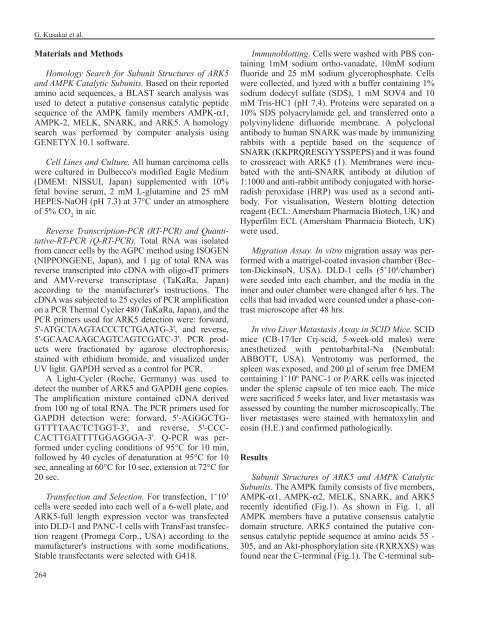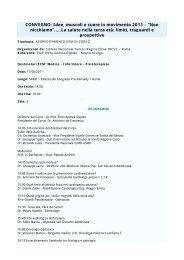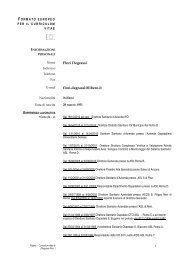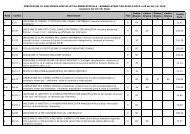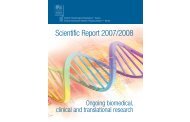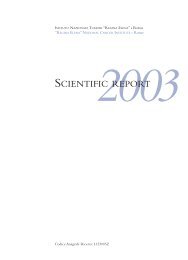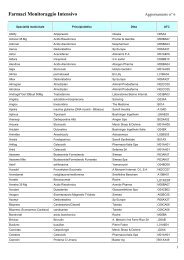Strong Association of ARK5 with Tumor Invasion and Metastasis
Strong Association of ARK5 with Tumor Invasion and Metastasis
Strong Association of ARK5 with Tumor Invasion and Metastasis
Create successful ePaper yourself
Turn your PDF publications into a flip-book with our unique Google optimized e-Paper software.
G. Kusakai et al.<br />
Materials <strong>and</strong> Methods<br />
Homology Search for Subunit Structures <strong>of</strong> <strong>ARK5</strong><br />
<strong>and</strong> AMPK Catalytic Subunits. Based on their reported<br />
amino acid sequences, a BLAST search analysis was<br />
used to detect a putative consensus catalytic peptide<br />
sequence <strong>of</strong> the AMPK family members AMPK-α1,<br />
AMPK-2, MELK, SNARK, <strong>and</strong> <strong>ARK5</strong>. A homology<br />
search was performed by computer analysis using<br />
GENETYX 10.1 s<strong>of</strong>tware.<br />
Cell Lines <strong>and</strong> Culture. All human carcinoma cells<br />
were cultured in Dulbecco's modified Eagle Medium<br />
(DMEM: NISSUI, Japan) supplemented <strong>with</strong> 10%<br />
fetal bovine serum, 2 mM L-glutamine <strong>and</strong> 25 mM<br />
HEPES-NaOH (pH 7.3) at 37°C under an atmosphere<br />
<strong>of</strong> 5% CO 2 in air.<br />
Reverse Transcription-PCR (RT-PCR) <strong>and</strong> Quantitative-RT-PCR<br />
(Q-RT-PCR). Total RNA was isolated<br />
from cancer cells by the AGPC method using ISOGEN<br />
(NIPPONGENE, Japan), <strong>and</strong> 1 µg <strong>of</strong> total RNA was<br />
reverse transcripted into cDNA <strong>with</strong> oligo-dT primers<br />
<strong>and</strong> AMV-reverse transcriptase (TaKaRa, Japan)<br />
according to the manufacturer's instructions. The<br />
cDNA was subjected to 25 cycles <strong>of</strong> PCR amplification<br />
on a PCR Thermal Cycler 480 (TaKaRa, Japan), <strong>and</strong> the<br />
PCR primers used for <strong>ARK5</strong> detection were: forward,<br />
5'-ATGCTAAGTACCCTCTGAATG-3', <strong>and</strong> reverse,<br />
5'-GCAACAAGCAGTCAGTCGATC-3'. PCR products<br />
were fractionated by agarose electrophoresis,<br />
stained <strong>with</strong> ethidium bromide, <strong>and</strong> visualized under<br />
UV light. GAPDH served as a control for PCR.<br />
A Light-Cycler (Roche, Germany) was used to<br />
detect the number <strong>of</strong> <strong>ARK5</strong> <strong>and</strong> GAPDH gene copies.<br />
The amplification mixture contained cDNA derived<br />
from 100 ng <strong>of</strong> total RNA. The PCR primers used for<br />
GAPDH detection were: forward, 5'-AGGGCTG-<br />
GTTTTAACTCTGGT-3', <strong>and</strong> reverse, 5'-CCC-<br />
CACTTGATTTTGGAGGGA-3'. Q-PCR was performed<br />
under cycling conditions <strong>of</strong> 95°C for 10 min,<br />
followed by 40 cycles <strong>of</strong> denaturation at 95°C for 10<br />
sec, annealing at 60°C for 10 sec, extension at 72°C for<br />
20 sec.<br />
Transfection <strong>and</strong> Selection. For transfection, 1˘10 5<br />
cells were seeded into each well <strong>of</strong> a 6-well plate, <strong>and</strong><br />
<strong>ARK5</strong>-full length expression vector was transfected<br />
into DLD-1 <strong>and</strong> PANC-1 cells <strong>with</strong> TransFast transfection<br />
reagent (Promega Corp., USA) according to the<br />
manufacturer's instructions <strong>with</strong> some modifications.<br />
Stable transfectants were selected <strong>with</strong> G418.<br />
264<br />
Immunoblotting. Cells were washed <strong>with</strong> PBS containing<br />
1mM sodium ortho-vanadate, 10mM sodium<br />
fluoride <strong>and</strong> 25 mM sodium glycerophosphate. Cells<br />
were collected, <strong>and</strong> lyzed <strong>with</strong> a buffer containing 1%<br />
sodium dodecyl sulfate (SDS), 1 mM SOV4 <strong>and</strong> 10<br />
mM Tris-HC1 (pH 7.4). Proteins were separated on a<br />
10% SDS polyacrylamide gel, <strong>and</strong> transferred onto a<br />
polyvinylidene difluoride membrane. A polyclonal<br />
antibody to human SNARK was made by immunizing<br />
rabbits <strong>with</strong> a peptide based on the sequence <strong>of</strong><br />
SNARK (KKPRQRESGYYSSPEPS) <strong>and</strong> it was found<br />
to crossreact <strong>with</strong> <strong>ARK5</strong> (1). Membranes were incubated<br />
<strong>with</strong> the anti-SNARK antibody at dilution <strong>of</strong><br />
1:1000 <strong>and</strong> anti-rabbit antibody conjugated <strong>with</strong> horseradish<br />
peroxidase (HRP) was used as a second antibody.<br />
For visualisation, Western blotting detection<br />
reagent (ECL: Amersham Pharmacia Biotech, UK) <strong>and</strong><br />
Hyperfilm ECL (Amersham Pharmacia Biotech, UK)<br />
were used.<br />
Migration Assay. In vitro migration assay was performed<br />
<strong>with</strong> a matrigel-coated invasion chamber (Becton-DickinsoN,<br />
USA). DLD-1 cells (5˘10 4 /chamber)<br />
were seeded into each chamber, <strong>and</strong> the media in the<br />
inner <strong>and</strong> outer chamber were changed after 6 hrs. The<br />
cells that had invaded were counted under a phase-contrast<br />
microscope after 48 hrs.<br />
In vivo Liver <strong>Metastasis</strong> Assay in SCID Mice. SCID<br />
mice (CB-17/Icr Crj-scid, 5-week-old males) were<br />
anesthetized <strong>with</strong> pentobarbital-Na (Nembutal:<br />
ABBOTT, USA). Ventrotomy was performed, the<br />
spleen was exposed, <strong>and</strong> 200 µl <strong>of</strong> serum free DMEM<br />
containing 1˘10 6 PANC-1 or P/ARK cells was injected<br />
under the splenic capsule <strong>of</strong> ten mice each. The mice<br />
were sacrificed 5 weeks later, <strong>and</strong> liver metastasis was<br />
assessed by counting the number microscopically. The<br />
liver metastases were stained <strong>with</strong> hematoxylin <strong>and</strong><br />
eosin (H.E.) <strong>and</strong> confirmed pathologically.<br />
Results<br />
Subunit Structures <strong>of</strong> <strong>ARK5</strong> <strong>and</strong> AMPK Catalytic<br />
Subunits. The AMPK family consists <strong>of</strong> five members,<br />
AMPK-α1, AMPK-α2, MELK, SNARK, <strong>and</strong> <strong>ARK5</strong><br />
recently identified (Fig.1). As shown in Fig. 1, all<br />
AMPK members have a putative consensus catalytic<br />
domain structure. <strong>ARK5</strong> contained the putative consensus<br />
catalytic peptide sequence at amino acids 55 -<br />
305, <strong>and</strong> an Akt-phosphorylation site (RXRXXS) was<br />
found near the C-terminal (Fig.1). The C-terminal sub-


